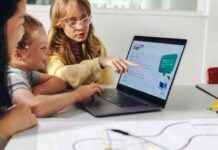Amidst the ongoing Covid-19 pandemic, American classrooms have undergone significant changes that are likely to have lasting effects on K-12 education. In a recent collaboration, Brian A. Jacob, the Walter H. Annenberg Professor of Education Policy and professor of economics at the Ford School, University of Michigan, joined Paul E. Peterson to delve into the implications of these changes. Their discussion centered around Jacob’s latest research, which presents findings from a survey of K-12 teachers aimed at understanding the potential long-term impacts of the pandemic.
### The Shift to Remote Learning
One of the most prominent trends that emerged in American classrooms post Covid-19 is the rapid shift to remote learning. With schools closing their doors to prevent the spread of the virus, educators were forced to adapt to virtual teaching methods almost overnight. According to Jacob’s research, this transition had varied impacts on teachers and students across different regions and demographics.
In urban areas, where access to technology and internet connectivity can be limited, the shift to remote learning posed significant challenges. Many students struggled to participate in online classes due to a lack of devices or reliable internet access. Teachers in these areas also faced difficulties in engaging students and ensuring they received the necessary support for their academic progress.
Conversely, suburban and rural schools fared slightly better in the transition to remote learning. With better access to technology and resources, students in these areas were able to continue their education with fewer disruptions. However, even in these settings, educators faced new challenges in adapting their teaching methods to an online format and maintaining student engagement.
### Impact on Student Learning
The move to remote learning also had a profound impact on student learning outcomes. Jacob’s research reveals that many teachers reported a decrease in student engagement and motivation during the period of remote instruction. Without the structure and routine of in-person classes, some students struggled to stay focused and motivated to complete their assignments.
Furthermore, disparities in academic achievement widened as a result of the shift to remote learning. Students from low-income backgrounds and marginalized communities were disproportionately affected by the lack of access to resources and support during this time. These students faced greater barriers to learning and were at risk of falling behind their peers who had better access to technology and educational resources.
### Teacher Well-being and Job Satisfaction
In addition to its impact on students, the Covid-19 pandemic also took a toll on teachers’ well-being and job satisfaction. Jacob’s research found that many educators experienced increased stress and burnout as they navigated the challenges of remote instruction and the uncertainties of the pandemic. The sudden shift to online teaching required teachers to adapt their lesson plans, communicate with students and parents, and provide support in new and unfamiliar ways.
Moreover, the lack of social interaction and support from colleagues during remote teaching further exacerbated feelings of isolation and loneliness among educators. Many teachers reported feeling disconnected from their professional community and struggled to find ways to collaborate and share resources with their peers.
### Looking Ahead: The Future of American Classrooms
As schools begin to reopen and students return to in-person learning, it is crucial to reflect on the lessons learned from the Covid-19 pandemic and consider how they can inform the future of American classrooms. Jacob’s research highlights the urgent need for investments in technology infrastructure and resources to ensure equitable access to education for all students.
Additionally, support and professional development opportunities for teachers are essential to help them navigate the challenges of teaching in a post-pandemic world. Providing educators with the tools and resources they need to effectively integrate technology into their teaching practices can help improve student outcomes and foster a more engaging and interactive learning environment.
In conclusion, the Covid-19 pandemic has brought about significant changes in American classrooms, from the shift to remote learning to the impact on student learning and teacher well-being. By addressing the challenges and disparities that have emerged during this time, we can work towards creating a more inclusive and equitable education system that meets the needs of all students and educators.







